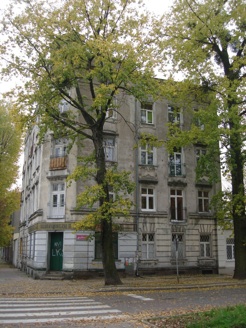Rybna 14a, Łódź
21 June 2013

The Łódź ghetto was established by the occupying German military as of February 8, 1940, although planning was already underway in December 1939, two months after the invasion. The ghetto was sealed off on April 30. The city’s large Jewish population was forced to move into an area in the poorer, northern section of the city called Bałuty, which had poor drainage and infrastructure. All non-Jews were required to leave. Starting in 1930, the Yiddish-language writer Izroel Rabon starting publishing a serialized novel in the Yiddish daily Lodzer Togblat depicting life in this part of town. Rabon’s novel, Balut*, gives an excellent idea of life among poor Jews in the neighborhood.
Like all other Jews in the city, Izrael Lejzerowicz moved to Bałuty during this period, bringing his elderly father with him. It is unclear how or why he came to live in the building at Rybna 14a, a corner building with a shop on the ground floor and a large courtyard in the center, typical of buildings in Łódź. One elderly survivor who lived in the building during the ghetto period reported a few years ago that he had taken the initiative to scout out the neighborhood for possible apartments for his family and grabbed one at Rybna 14a as soon as he could, rather than wait to be assigned a space by the authorities. Perhaps Lejzerowicz did the same, as the building has both large and small apartments and was in comparatively good condition. For a painter, a studio with good windows was basic to any hope of working. And working meant the possibility of survival. From the beginning that was already evident.
An unofficial count of people who lived at Rybna 14a during the ghetto period numbers some 320 individuals from all walks of life: artist painter, baker, bank employee, barber, bookkeeper, brush maker, building superintendent, cabinetmaker, capmaker, civil servant, cutter, darner, dealer, editor, engineer, farmer, fireman, fitter, glove-maker, hand-sewer, housewife, knitter, laborer, manufacturer, merchant, midwife, nurse, office clerk, office worker, packer, painter, paperhanger, plumber, porcelain painter, quilter, rabbi, schoolchild, seamstress, seminary student, storekeeper, sugarmaker, tailor, tanner, thread-twister, trainer, washerwoman, weaver.
It was in his studio in this building - which still stands today - that Lejzerowicz hosted a writers’ group that met periodically. The original owners (Polish Christians) returned after the war when they were allowed back into the neighborhood. When they returned, they found the building nearly in ruins: anything that could be sold or burned for fuel had been ripped out. Over the succeeding years, they managed to restore the building and bring it back into use.

*Although incomplete, the novel was republished in a French version in 2006 as Balut, roman d’un faubourg. Montreuil, France: Editions Folies d’encre.